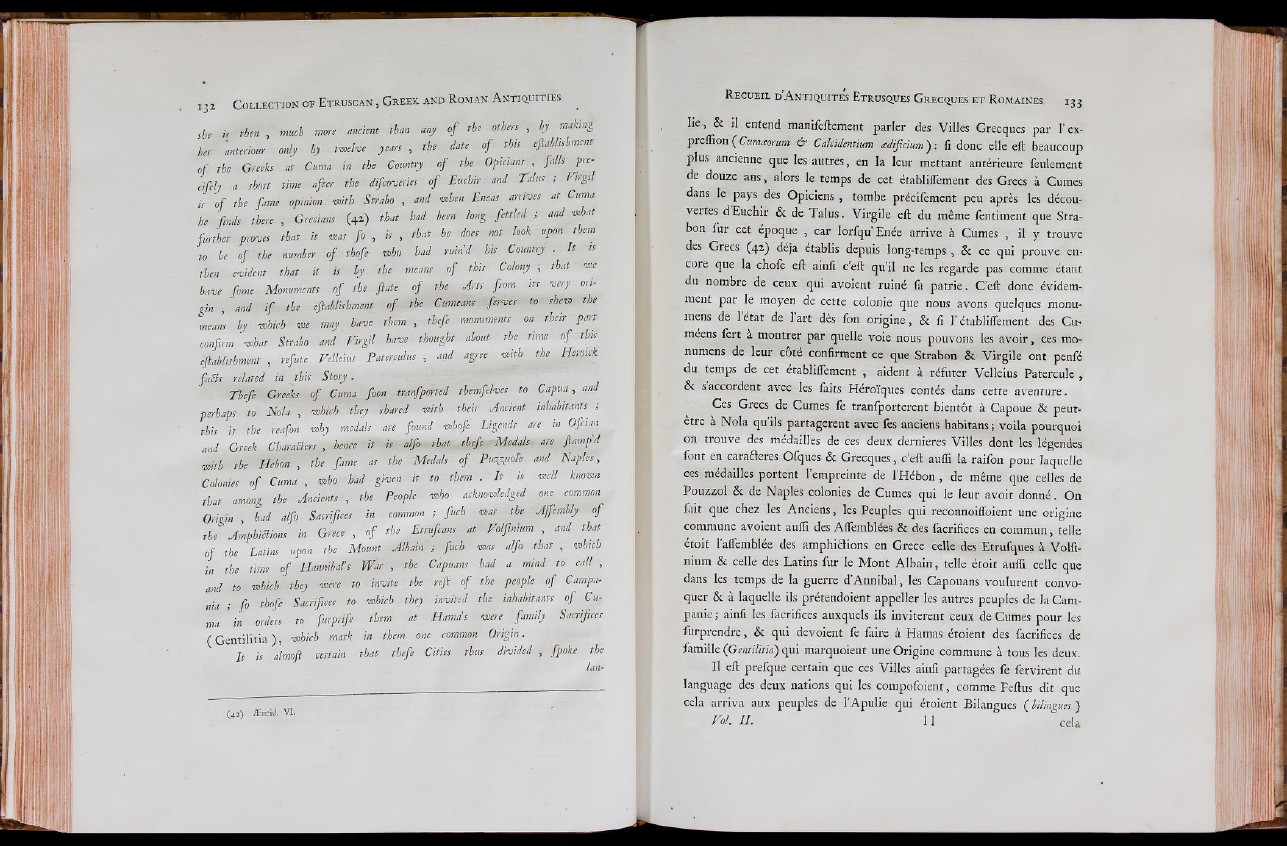
,be is then , much more ancient than any o f the others , hy making
her 'anteriour only hy twelve years , the date of this e f ta h U M t
o f the Greeks at Cuma in the Country o f the Op,cans , fd ls prcafely
a short time after the difcoveries o f Euchir and Talus ; Virgil
ir o f the fame opinion with Strabo , and when Eneas arrives at Cuma
he finds there , Grecians (42) that bad been long fettled ; and what
further proves that it was fo , tV , that he does not look upon them
'to be o f the number o f thofe who had ruin’d bis Country . I t is
then evident that it is by the means of this Colony , that we
have fome Monuments o f the ftate o f the Arts from its very origin
, and i f the cftablishmcnt o f the Cumcans firvcs to shew the
means by which wc may have them , thefe monuments on their part
confirm what Strabo and Vtrgd have thought about the time o f this
cftablishmcnt , refute Velleius Paterculus , and agree with the Hcroick
faSts related in this Story.
Thefe Greeks o f Cuma foon tranfported themfelves to Capua, and
perhaps to Nola , which they shared with their Ancient inhabitants ;
this is the reafon why medals are found wbofe Ligcnds are in Ofcian
and Greek CharaBers , hcncc it is alfo that thefe Medals are ftamp d
with the Hebon , the fame as the Medals o f Puzguole and Naples,
Colonies o f Cuma , who had given it to them . I t is well known
that among the Ancients , the People who ackno-wlcdged one common
Origin , had alfo Sacrifices in common ; fuch was the AJJcmbly o f
the AmpbiBions in Grccc , o f the Etrufcans at Volfinium , and that
of the Latins upon the Mount Alhain ; fuch was alfo that , which
in the time of Hannibal’s War , the Capuans bad a mind to call ,
and to which they were to invite the reft o f the people o f Campania
; fo thofe Sacrifices to which they invited the inhabitants o f Cuma
’ in orders to furprife them at llama’s were family Sacrifices
( G e n t ilit ia ) , which mark in them one common Origin.
I t is almoft certain that thefe Cities thus divided , [poke the
Ian-
( 4 2 ) Æ n e id . V I .
lie, & il entend manifeftement parler des Villes Grecques par f expreffion
( C»m.<roram cr Calcidentium xdificium): fi donc elle eft beaucoup
plus ancienne que les autres, en la leur mettant antérieure feulement
de douze ans, alors le temps de cet établilfement des Grecs à Cumes
dans le pays des Opiciens , tombe précifément peu après les découvertes
d Euchir & de Talus. Virgile eft du même fentiment que Strabon
fur cet époque , car lorfqu’Enée arrive à Cumes , il y trouve
des Grecs (42) déjà établis depuis long-temps , & ce qui prouve encore
que la chofe eft ainfi c’eft qu’il ne les regarde pas comme étant
du nombre de ceux qui avoient ruiné fa patrie. Ceft donc évidemment
par le moyen de cette colonie que nous avons quelques monumens
de l’état de l’art dès fon origine, & fi f établilfement des Cuméens
fert a montrer par quelle vole nous pouvons les avoir, ces monumens
de leur côté confirment ce que Strabon & Virgile ont penfé
du temps de cet établilfement , aident à réfuter Velleius Patercule ,
& s accordent avec les faits Héroïques contés dans cette aventure.
Ces Grecs de Cumes fe tranfporterent bientôt à Capoue & peut-
être à Nola qu’ils partagèrent avec fes anciens habitans ; voila pourquoi
on trouve des médailles de ces deux dernieres Villes dont les légendes
font en caraderes Ofques & Grecques, c’eft auffi la raifon pour laquelle
ces médailles portent l’empreinte de l’Hébon , de même que celles de
Pouzzol & de Naples colonies de Cumes qui le leur avoit donné. On
iait que chez les Anciens, les Peuples qui reconnoilfoient une origine
commune avoient auffi des Alfemblées & des facrifices en commun, telle
étoit l’alfemblée des ampliidions en Grece celle des Etrufques à Volfinium
& celle des Latins fur le Mont Albain, telle étoit auffi celle que
dans les temps de la guerre d’Annibal, les Capouans voulurent convoquer
& à laquelle ils prétendoient appeller les autres peuples de la Campanie
; ainfi les facrifices auxquels ils invitèrent ceux de Cumes pour les
furprendre, & qui devoient fe faire à Hamas étoient des facrifices de
famille qui marquoient une Origine commune à tous les deux.
Il eft prefque certain que ces Villes ainfi partagées fe fervirent du
language des deux nations qui les compofoient, comme Feftus dit que
cela arriva aux peuples de l’Apulie qui étoient Bilangues (bilingues)
Vol. I L 11 cela
iliFÜil:
i | | i
U
rii ii.
l i : !